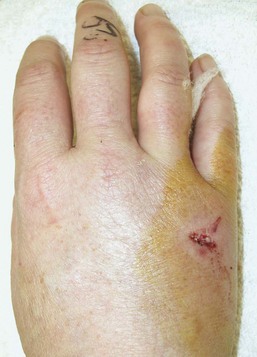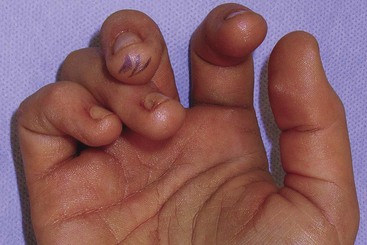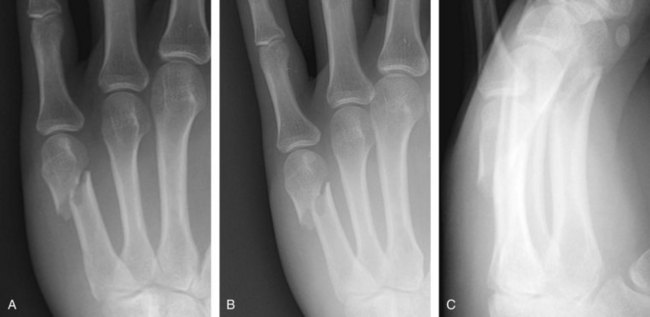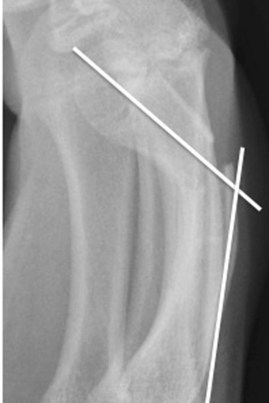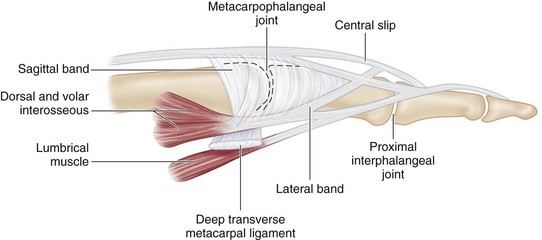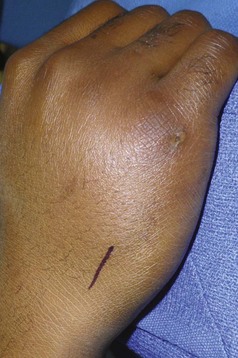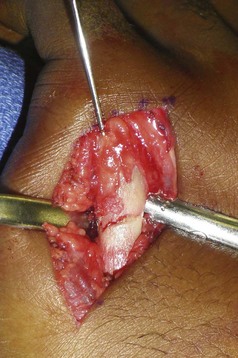Procedure 54 Metacarpal Neck Fractures
Examination/Imaging
Clinical Examination
 Note swelling and bruising over the dorsum of the hand.
Note swelling and bruising over the dorsum of the hand.
 Look carefully for any wounds—may indicate an open fracture (Fig. 54-1).
Look carefully for any wounds—may indicate an open fracture (Fig. 54-1).
 Look carefully for rotational deformity with fingers flexed and compared with opposite hand (Fig. 54-2).
Look carefully for rotational deformity with fingers flexed and compared with opposite hand (Fig. 54-2).
 Ensure circulation is adequate by checking capillary refill.
Ensure circulation is adequate by checking capillary refill.
 Test and document digital sensation.
Test and document digital sensation.
 Ask patient to flex and extend interphalangeal joints within limits of pain to confirm continuity of flexor and extensor tendons.
Ask patient to flex and extend interphalangeal joints within limits of pain to confirm continuity of flexor and extensor tendons.
Surgical Anatomy
 Metacarpals can be easily accessed through the dorsal approach.
Metacarpals can be easily accessed through the dorsal approach.
 Dorsal cutaneous nerves are located in the subcutaneous plane. The dorsal cutaneous branch of the ulnar nerve winds around the ulnar border of the hand 1 cm distal to the ulnar head and then divides into its branches at the level of the small finger carpometacarpal joint.
Dorsal cutaneous nerves are located in the subcutaneous plane. The dorsal cutaneous branch of the ulnar nerve winds around the ulnar border of the hand 1 cm distal to the ulnar head and then divides into its branches at the level of the small finger carpometacarpal joint.
 The extensor tendons are surrounded by paratenon and can be easily separated by dividing the juncturae tendinum that interconnect them at the level of the metacarpal necks.
The extensor tendons are surrounded by paratenon and can be easily separated by dividing the juncturae tendinum that interconnect them at the level of the metacarpal necks.
 The extensor hood envelops the distal part of the metacarpal. Plate placement at this level can interfere with gliding of the hood (Fig. 54-5).
The extensor hood envelops the distal part of the metacarpal. Plate placement at this level can interfere with gliding of the hood (Fig. 54-5).
Positioning
 The patient is positioned supine with the arm on a hand table.
The patient is positioned supine with the arm on a hand table.
 The surgeon is seated on the cephalad side of the table with the forearm pronated to allow access to the dorsum of the hand.
The surgeon is seated on the cephalad side of the table with the forearm pronated to allow access to the dorsum of the hand.
Exposures
 For open plating, a longitudinal incision is centered over the metacarpal neck. The incision is on the dorsum for the long and ring fingers. For the border digits—index and small fingers—the incision is on the midlateral line and then curves dorsally at the metacarpophalangeal joint (Fig. 54-6).
For open plating, a longitudinal incision is centered over the metacarpal neck. The incision is on the dorsum for the long and ring fingers. For the border digits—index and small fingers—the incision is on the midlateral line and then curves dorsally at the metacarpophalangeal joint (Fig. 54-6).
 For intramedullary pinning, the incision is placed at the metacarpal base (Fig. 54-7).
For intramedullary pinning, the incision is placed at the metacarpal base (Fig. 54-7).
 The periosteum at the fracture site is elevated circumferentially to allow accurate reduction without soft tissue interposition.
The periosteum at the fracture site is elevated circumferentially to allow accurate reduction without soft tissue interposition.
Pearls
For plating of adjacent metacarpals, a single skin incision between the metacarpals will allow access to both fractures.
Careful spreading dissection is necessary after skin incision to preserve subcutaneous nerves and veins.
Paratenon around extensor tendons must be preserved to minimize postoperative tendon adhesions.
With exposure for intramedullary pinning of the small finger, particular care must be taken to identify and preserve the dorsal branch of the ulnar nerve.
In case of excessive comminution, the periosteum around the fracture is left intact, and the implant is secured distally and proximally (bridge plating).
Procedure
Step 1: Preparation of Plate and Insertion of Blade
 Achieve provisional reduction and stabilize with a K-wire (Fig. 54-8).
Achieve provisional reduction and stabilize with a K-wire (Fig. 54-8).
 Select the appropriate-sized condylar plate.
Select the appropriate-sized condylar plate.
 The plate is held against the fracture, and the required length of plate is determined. The plate is cut to appropriate length (Fig. 54-9).
The plate is held against the fracture, and the required length of plate is determined. The plate is cut to appropriate length (Fig. 54-9).
 The blade hole is drilled first in the metacarpal head. The plate is rotated such that the blade is pointing away from the bone, and the plate hole adjacent to the blade is drilled with the drill directed parallel to the blade (Fig. 54-10).
The blade hole is drilled first in the metacarpal head. The plate is rotated such that the blade is pointing away from the bone, and the plate hole adjacent to the blade is drilled with the drill directed parallel to the blade (Fig. 54-10).
 The hole is measured, and the blade is cut to the appropriate length.
The hole is measured, and the blade is cut to the appropriate length.
 The blade is inserted into the hole, and the plate is approximated with the shaft using a bone clamp (Fig. 54-11).
The blade is inserted into the hole, and the plate is approximated with the shaft using a bone clamp (Fig. 54-11).
Stay updated, free articles. Join our Telegram channel

Full access? Get Clinical Tree








